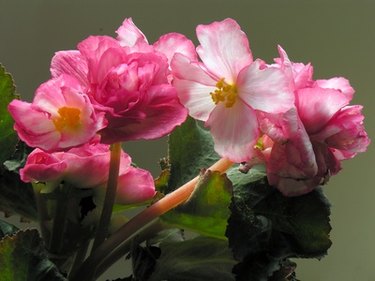Things You'll Need
Seedling flats
Peat moss
Plant mister
Nonstop begonia tubers
Six-inch seedling pots
Hanging baskets
Potting soil
Newspaper
Garden shears
Brown paper bag
Staple gun
Marker

Nonstop begonias are a variety of tuberous begonia that is popular among gardeners for their rose-like display of flowers which grow between two and four inches in size in colors of white, orange, pink, yellow and red. The trailing behavior of these flowers makes them a popular choice for hanging baskets. Nonstop begonias do well in partial shade, and tend to do poorly in climates with high humidity and heat. The tuberous plants may be dug up and overwintered, and then replanted in the spring.
Step 1
Fill a seedling flat with peat moss and mist until the soil is as damp as a wrung-out sponge. Hollow out planting holes for tuberous begonias. Place begonias in planting holes and cover lightly with peat moss.
Video of the Day
Step 2
Place seedling flats in a windowsill that provides sun but not direct sunlight. Continue to mist to keep soil moist.
Step 3
Transplant begonias when seedlings are two inches tall by filling six-inch plastic seedling pots with peat moss. Then mist until the peat moss is damp. Scoop out soil in the center of the pot to make a planting hole. Lift a begonia from the flat and place in the planting hole in the six-inch pot. Cover with peat moss. Place seedling pots in a sunny windowsill out of direct sunlight and continue to keep peat moss damp.
Step 4
Pinch off any young flower buds so that seedling begonias will put all of their energy into developing a strong plant and root system.
Step 5
Transplant begonia tubers into hanging baskets when the roots start to stick out of the bottom of the six-inch pot. To do this, fill a hanging basket with potting soil. Create a planting hole that is six inches wide and as deep as the seedling pot by scooping out dirt from the center of the basket. Pull the begonia from the seedling pot by supporting the stem of the begonia and turning the pot on its side. Tap the side of the pot to release the root ball and then upend it to let gravity pull the root ball free. Place the root ball into the planting hole in the hanging basket and cover with soil. Water well so that the soil is as damp as a wrung out sponge. Hang the basket outdoors in an area that receives partial sun once all danger of frost has passed.
Step 6
Wait until the first frost of fall before storing your begonias. Lift the tubers from the hanging basket by tipping the basket on its side and loosening the soil. Pull the begonia tubers from the basket and lay them onto a piece of newspaper. Allow the begonia tubers to dry for two weeks. Trim away dead foliage, then fill a brown paper sack with peat moss. Place begonias into the paper sack. Fold the top of the sack over and staple closed. Label the sack with the contents and the date using a marker. Store in a cool dry place such as an unheated garage that will remain between 45 and 55 degrees.
Video of the Day